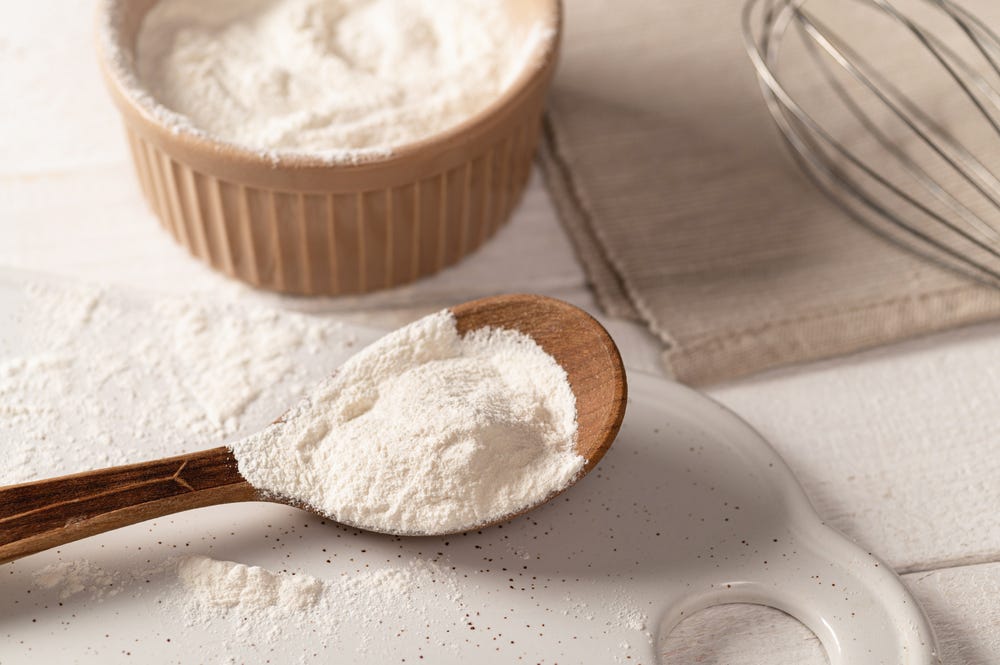If you have ever bought a pint of ice cream, salad dressing, or gluten-free bread undoubtably that product contains xanthan gum. Although the name and sound of the ingredient does not elicit images of purity, xanthan gum is used throughout molecular gastronomy as well as the food, beverage, cosmetic, and oil industries.
In the oil industry, xanthan gum is used to thicken drilling mud. In the cosmetic industry, it is used to create water gels. In molecular gastronomy, xanthan gum is used to stabilize foams and emulsions and create gels to suspend solid materials. In the food and beverage industry, it is used to help thicken sauces, dressings, or any other type of liquid. It also helps prevent the food or beverage from separating during its time on the grocery store (or pantry) shelf. Recently, it is also becoming popular in gluten-free baking. Available in grocery stores, home cooks can use xanthan gum to help hold ingredients together and retain moisture in the baked product.
Xanthan gum was discovered in the 1960s by a United States Department of Agriculture (USDA) research team when they were searching for a plant-based gum that could be produced in the United States. It was brought to commercial production by a gum manufacturer, CP Kelco, later in the decade. The Federal Drug Administration (FDA) approved it for use in food and beverage products in 1968 and it is currently approved for use in countries throughout the world.
Xanthan gum is made via fermentation by the bacteria, Xanthomonas campestris. This bacterial strain is not harmful to humans or animals and is naturally present on green leaf surfaces (sometimes contributing to black rot and bacterial wilt). To create xanthan gum, sugar from corn, wheat, or soy is combined with the bacteria. When the bacteria ferments the sugar, the resulting by-product is a thick gel that is pasteurized (to kill off any remaining bacteria), dried, and milled into a fine, white powder.
Nutritionally, xanthan gum is a soluble fiber; which means that the body cannot break it down. When it is consumed, it absorbs water and forms a gel, slowing down digestion. This causes the person to feel full for a longer amount of time. Several studies have found that it might lower blood sugar by slowing down the rate that sugar is absorbed into the blood stream. Other benefits might include lowering cholesterol, increasing weight loss, improving bowel movement regularity, and improving gut health. However, these studies used xanthan gum at levels 10-20 times which is seen in a normal diet. So, it is hard to predict whether these benefits extend to normal dietary dosages.
The World Health Organization (WHO) and FDA have approved the use of xanthan gum as a food additive at 10 milligrams/kilogram of body weight. So, for a 150-pound person this would be about 3.1 grams per day. It is estimated that most people consume 1 gram or less of xanthan gum per day, far less than the upper recommended limit. There are no reported side-effects or negative studies of xanthan gum, when it is consumed as a food additive. However, people who are severely allergic to corn, wheat, or soy might want to avoid xanthan gum since the starting sugar material can come from one (or more) of these sources. With that being said, xanthan is typically present in small amounts (0.05%-0.30%) in a food or beverage product, so the risk of an allergic reaction is extremely small. Additionally, it has been reported that xanthan gum should not be given to pre-mature infants and newborns since their guts are still developing.
Where have you seen xanthan gum?




